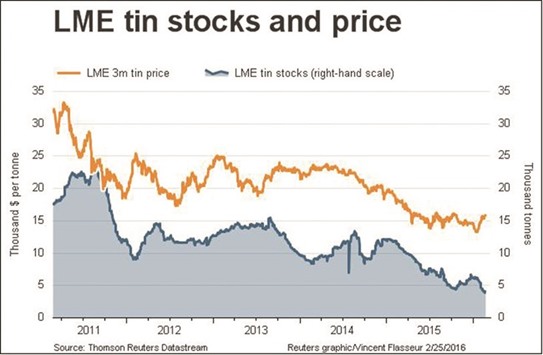Tin is defying the downdraft sweeping commodity markets, with prices for the metal used to solder electronics surging this year thanks to reduced production in major exporter Indonesia.
Prices of many commodities, ranging from base metals to oil, have been hammered by oversupply and concerns about weakening demand in top raw materials consumer China.
But tin has bucked the trend, buoyed by the Indonesian cuts, which have countered slowing demand in the electronics sector and helped push down exchange stockpiles of the metal to their lowest levels since 2008.
It has been the best performer on the London Metal Exchange (LME) this year, rising about 10% to around $16,000 a tonne, against a largely flat index of six industrial metals and a drop in the Thomson Reuters/Core Commodity CRB Index of 10%.
“The fact that (Indonesia) has reduced their yearly exports, stocks are below 4,000 tonnes ... has attracted funds again,” said a tin trader at a global trading house in Europe. “I won’t be surprised to see the price rallying to $18,000.”
Many industry experts say the rally could run out of steam in the coming weeks or months, however, partly due to surging tin output from Myanmar – though they expect prices to resume their uptrend towards the end of the year.
Caroline Bain, senior commodity economic at consultancy Capital Economics, predicted prices would reach $17,000 by the end of 2016, helped by a pick-up in demand from the electronics sector – which accounts for around half of global consumption of tin, used as solder to fuse together circuitry components.
Global semiconductor sales – a barometer for electronics demand – dropped 5.2% year-on-year in December, according to the Semiconductor Industry Association.
“The demand side is quite subdued, although there are some early indications that the electronic sector could be picking up,” said Bain. It has been a sharp turnaround for tin. Prices were languishing at 6-1/2 year lows in January before Indonesian exports fell by 63% after authorities tightened export rules and launched new audits of smelters, helping to trigger the rally.
They hit a peak of $16,200 a tonne on Tuesday, their strongest level since October, following news that major Indonesian tin smelter PT Refined Bangka Tin (RBT) would be scrapped. Smelters process ore into refined metal.
LME tin inventories have fallen to 3,850 tonnes, their lowest since November 2008, indicating shortages on the market.
Industry group ITRI said flooding in a major tin-producing region on Indonesia was expected to further reduce exports from the country in February.
“Recently we’ve been surveying the individual tin producing companies on their output and pretty much everybody is reporting lower production,” said Peter Kettle, markets manager at ITRI.
Global refined tin output is forecast to fall 3% this year after a decline of 8% in 2015, resulting in a global deficit of 10,000-15,000 tonnes, he added.
However tin prices are likely to be pressured in the coming weeks and months, partly from the rising production in Myanmar. Chinese imports from the nation jumped 240% in January, although analysts said it was uncertain that such high levels could be sustained. “We saw the run-up in prices on that tin smelter shutting down, but then we got the data showing huge imports from Myanmar, which seemed to compensate for any loss out of Indonesia,” said Robin Bhar, head of metals research at Societe Generale in London.
The LME stocks picture is also not the whole story on inventories, warned Capital Economics’ Bain.
“If you look at the exchange stocks alone, you would wonder why the price isn’t double what it is now, but certainly there are anecdotal reports that producer stocks of tin in Indonesia are high.”
A plea by Chinese tin producers to the government to stockpile tin also implied excess stocks there, she added.
“We do expect tin prices to pick up by the end of this year, but people are right to be cautious about how tight the tin market really is.”

KRISHNAN


